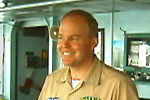| |
Participant
Interview:
Interview: Commanding Officer Roger L. Parsons, Captain
NOAA Ship Ron Brown
Jeff: How
did you acquire the skills to become a ship captain?
Roger: I have a bachelor's degree in meteorology and oceanography and
a Coast Guard's Third Mate's License so it seemed like an ideal way to
apply both my interest in the oceans, the ship driving aspects and academic
aspects as well. Through progressive assignments over the last 25 years,
here I am on the Brown. I've done some graduate work in oceanography dealing
with the speed of sound in water. The knowledge comes in handy when working
with scientists.
Jeff: Did
you spend a lot of time at sea when you were young?
Roger: No. I never went boating as a kid. I became interested in oceanography,
I guess like everybody back in the 60's, by watching Jaques Cousteau on
TV. I picked a college that I could major in oceanography and from there
it took off.
Jeff: How
does NOAA assist scientists in their oceanographic research?
Roger: We are essentially a service organization. We provide a platform
(ship) to assist the scientists in their research goals, we provide hardware,
the ship handling, the crew, and the administration of the vessel.
Jeff: What
would you recommend for young people interested in going into your field?
Roger: A strong academic background, especially in math and science. Also,
good writing and reasoning skills are essential. You need a process for
logical reasoning.
Jeff: What
is the longest time you've spent at sea?
Roger: On this ship, 40 days. This ship could go for several months but
a lot of the scientific missions are planned around 40 days. You can't
keep a crew out too long without getting them into port because they are
working 24 hours a day, 7 days a week. There are no holidays out here.
Monday is like a Saturday, it doesn't make any difference. 40 days is
about the time folks start getting edgy and it's good to get them into
port and grounded.
|
|

Captain Parsons on the bridge,
NOAA Ship Ron Brown
|
|

